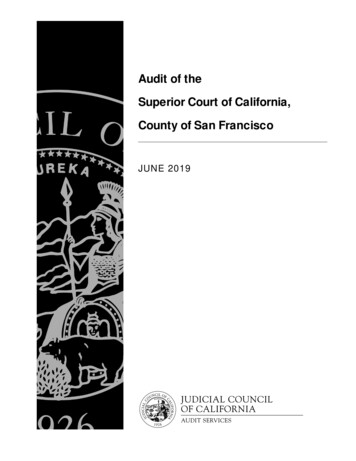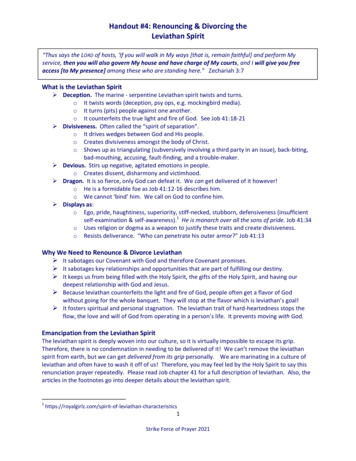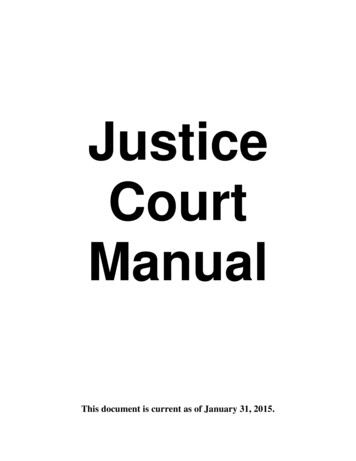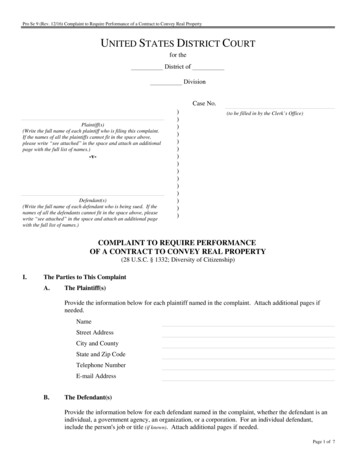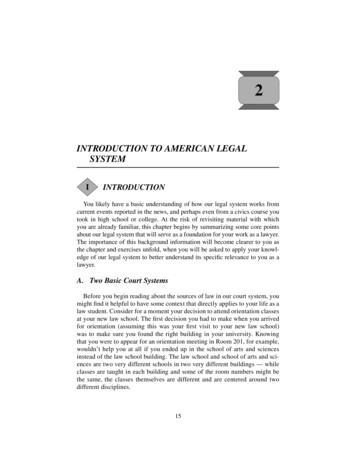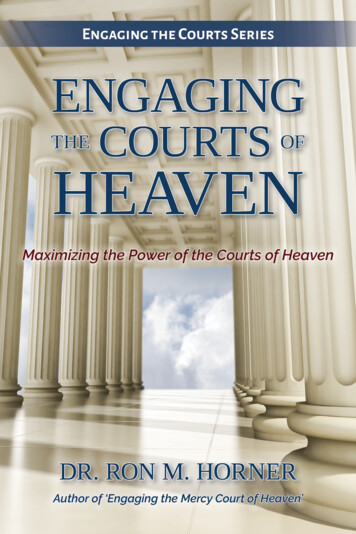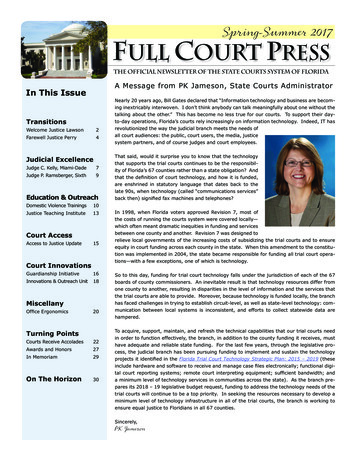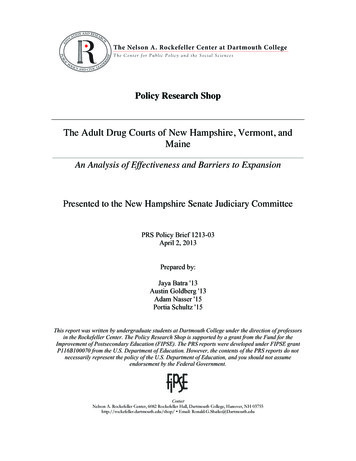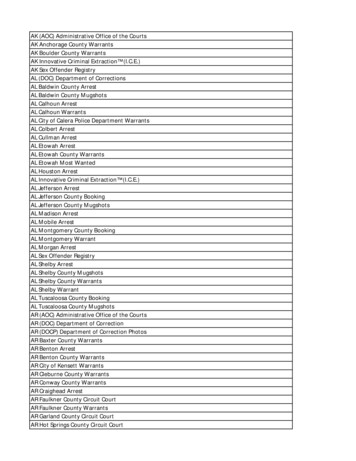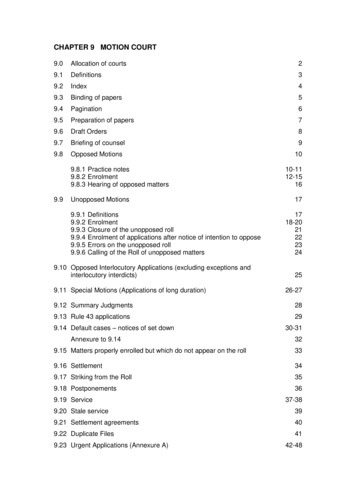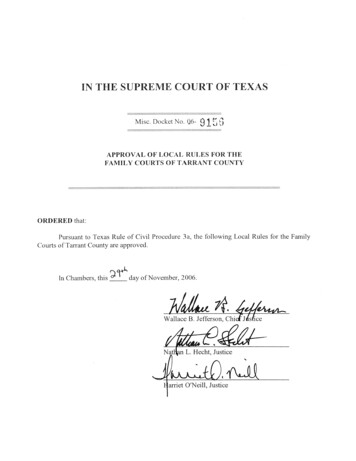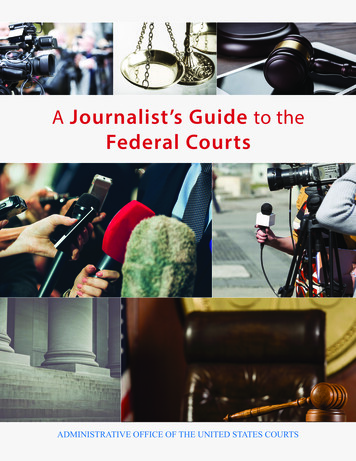
Transcription
A Journalist’s Guide to theFederal CourtsADMINISTRATIVE OFFICE OF THE UNITED STATES COURTS
This page is intentionally blank.
AJournalist’s Guideto theFederal CourtsAdministrative Office of the United States CourtsThurgood Marshall Federal Judiciary BuildingWashington D.C. 20544www.uscourts.gov
This page intentionally blank.
ContentsIntroduction1Federal Court: Media Basics2Media Access in Brief2Recording and Broadcasting4Electronic Devices5Courthouse Contacts6Judges6Clerk of Court’s Office7Lawyers7Jurors8Other District Court Personnel9Accessing Court Documents11Online Access11Older Documents12User Fees12Sealed Documents and Closed Hearings13District Courts15Reporting on Criminal Cases15Investigations and Related DocumentsGrand Juries and IndictmentsFelony Preliminary ProceedingsCriminal Complaints and InformationsPretrial MotionsGuilty PleasCovering Criminal Trials15161718191920The JuryOpening StatementsWitnessesExhibits, Transcripts, and Courtroom AudioMotion to AcquitClosing ArgumentsJury Instructions, Deliberations, and the Verdict20222222242425A Journalist’s Guide to the Federal Courtsi
Post-Verdict InterviewsNon-Capital SentencingDeath Penalty SentencingCovering Civil CasesFiling the ComplaintThe Plaintiff’s ClaimThe Defendant’s AnswerPretrial ProceedingsEnding a Case Without a TrialSummary JudgmentSettlementsCivil TrialsAppellate Courts and Cases3334The Appeals Process35Appeals Raising Constitutional Issues36Death Penalty Appeals36Three-Judge Panels3638Accessing Bankruptcy Records38Bankruptcy Process39Bankruptcy Appeals40Judges and Judicial Administration41Federal Judges41Federal Court Organization43Judicial Administration44Circuit Judicial Councils44Chief Judges45Judicial Disciplinary Process45Other Judiciary Entities 2828293031313131Appellate Court Sources and ResourcesBankruptcy Courts and Casesii2626272747Criminal Justice Act Defense System (Court-Appointed Counsel)47Who Provides Court-Appointed CounselHow CJA Cases Are FundedThe CJA and Death Penalty CasesProbation and Pretrial Services Officers48484950Central Violations Bureau52Helpful Online Resources53
IntroductionFederal judges and the journalistswho cover them share an importantgoal: They want the public toreceive accurate and understandableinformation about the federal courtsand their work.The media perform an importantand constitutionally protected role byinforming and educating the public.The media also serve a time-honoredrole as the public’s watchdog overgovernment institutions, including thecourts. Likewise, courts uphold manyof the legal protections that enablejournalists to perform their jobs. A Journalist’s Guide to the Federal Courts is intendedto assist reporters who cover appellate, district, and bankruptcy courts – the cases,the people, and the process. It also offers basic information for journalists writingabout the federal court system as a whole. The guide does not discuss the SupremeCourt of the United States. Go to the Supreme Court website (https://www.supremecourt.gov/) for helpful resources.The Guide is intended to help working reporters perform their professional duties;it is not a comprehensive overview of the federal courts. The U.S. Courts websiteoffers additional online resources about the federal Judiciary (http://www.uscourts.gov/about-federal-courts).The Guide does not constitute a statement of Judicial Conference policy and isnot binding on any federal court or its judges or employees. Individual courts havevaried approaches to media relations. Journalists should familiarize themselves withthe customs, practices, and rules of the courts they cover.In addition to this Guide, you may consult www.uscourts.gov and the Office ofPublic Affairs at the Administrative Office of the U.S. Courts, (202) 502-2600.Search for specific court location and website information using the Court roduction1
Federal Court:Media BasicsFederal courts are public institutions, and with rare exceptions, members of themedia and public can enter any courthouse and courtroom. However, whether you’rereporting about a high-profile case or the federal courthouse is part of your beat, theJudiciary has distinct differences from the other branches of the federal government,which often affect a reporter’s experience. Here are some notable differences: Legal terms. Reporters don’t need a law degree to cover the federal courts,but it is essential to understand and be able to translate legal jargon andprocedures for readers or viewers. When in doubt, check the Glossary ofLegal Terms (http://www.uscourts.gov/glossary). Each court is unique. While some rules and statutes govern all federal courts,circuits and districts have substantial autonomy to determine local rules andpractices. Understanding the rules will inform your coverage and ease yournewsgathering. Impartiality. Federal judges adhere to strict ethics guidelines and recusethemselves from cases that constitute a conflict of interest or in which theirimpartiality might reasonably be questioned. Cases are assigned to judgesrandomly in appellate, district, and bankruptcy courts to ensure fairness andintegrity. Official proceedings, not interviews. In keeping with ethics rules, federaljudges do not grant interviews about active cases. Judges “speak” throughcomments made in open court or through written decisions. Reporters mustrely on the official case proceedings as their primary information source.MEDIA ACCESS IN BRIEFJournalists have the same access to courthouses and court records as other membersof the public. This access is governed by a mix of federal laws, federal judicial policy,and circuit or district courts’ local rules and practices.Court documents. Most documents are filed electronically in appellate, district, andbankruptcy courts, and are available through the Public Access to Court ElectronicRecords service, better known as PACER (www.pacer.gov). PACER documentsalso can be read at no cost from a public terminal in the clerks’ offices. A list of2Federal Court: Media Basics
documents not available to the public can be found at AccessingCourt Documents on page 11.Interviews. Judges, court staff, and jurors may not discuss active cases.The clerk’s office usually is a court’s designated point of contact withthe media.Courthouse security. Members of the public must pass through ametal detector and agree to any additional requested screening bycourt security officers to enter a federal courthouse. Some courtspermit expedited entry of reporters with recognized credentials. Theclerk of court can tell you if this is available.Courtroom access. Most court proceedings are open to the public ona first come, first served basis. When in doubt, consult with the clerk’soffice before a trial or hearing to learn whether there are special mediaarrangements, such as reserved courtroom seating or a separate mediaroom.Journalistsshould notcross from thepublic galleryinto the well ofthe courtroom,which isgenerallymarked bya short rail,withoutpermissionfrom the judgeor a courtemployee.Closed sessions. Certain proceedings are always closed to the publicand media. By rule, only a witness, attorneys for the government,and a court reporter may be present when a grand jury sits, and jurydeliberations and attorney-client meetings also occur in private.These rules are designed to protect the integrity of the process andpreserve the right to a fair and impartial trial. Proceedings that dealwith classified information, trade secrets, and ongoing investigationsoften are closed. Judges also may meet privately with the attorneys inchambers.Most pretrial hearings are open to the public, but either party mayfile motions asking the judge to close certain proceedings. Mediaorganizations may choose to file an opposing motion when this occurs.Off limit areas. Journalists should not cross from the public galleryinto the well of the courtroom, which is generally marked by ashort rail, without permission from the judge or a court employee.Throughout the courthouse, journalists should obey posted restrictionsand instructions from court security officers. Failure to obeycourthouse rules may result in sanctions.A Journalist’s Guide to the Federal Courts3
RECORDING AND BROADCASTINGThe use of cameras in federal courtrooms is governed by the Judicial Conference ofthe United States and Federal Rules of Criminal Procedure. Find the full historyof Judiciary policy on cameras at as-courts.In specific instances, such as investitures, naturalizations, or other ceremonialproceedings, a judge may permit the public and media to take photographs andconduct video and audio recording inside a courthouse. And by local rule, the Secondand Ninth Circuit Courts of Appeals will consider media requests to record orbroadcast an appellate proceeding. Guidelines are available at the Second (http://www.ca2.uscourts.gov/media information.html) and Ninth Circuit (https://www.ca9.uscourts.gov/news media/) websites.Outside these limited exceptions, the media may not photograph, videotape, orrecord live federal court proceedings.Courts of appeals may provide audio or video recordings of appellate hearings, andrules are available on each circuit’s website. The Ninth Circuit website provides live,streaming video of oral arguments.In addition, three district courts in the Ninth Circuit – the District Court for theNorthern District of California, the District Court of Guam, and the District Courtfor the Western District of Washington – provide court-recorded video of some civiltrials. These videos, authorized by Judicial Conference policy, can be seen at Camerasin Courts ras-courts).4Federal Court: Media Basics
Even in courtsthat permit cellphones andother electronicdevices, trialrelated activitymay not berecorded.Some district and bankruptcy court proceedings use audio recordinginstead of a court reporter, and those recordings are available to thepublic for a fee (See Exhibits, Transcripts, and Courtroom Audioon page 22). A judge also may permit courtroom video and audiorecording for security purposes, and for other purposes of judicialadministration, but these recordings are not available to the public.It is important to note that the prohibition on recording includesthe use of cell phones and other personal electronic devices, evenin courthouses where the public is permitted to carry such devices.Journalists must not record or photograph trial-related activity, eitherin the courtroom or in areas where closed-circuit audio or video isavailable. Violation of this rule can result in significant court sanctions.Under local rules, courts may specify areas away from the courtroomwhere cameras can be used for interviews and TV reports. These areasusually are outside the courthouse, on or just outside federal courtproperty.ELECTRONIC DEVICESCircuits and districts set local rules on whether the public and mediamay bring portable electronic communication devices (such as cellphones, laptops, and tablets) into their courthouses, and where andwhether such devices may be used. For guidance on personal electronicdevices, consult the local court’s rules or administrative/standingorders on its website, or contact the clerk’s office.Even if a court generally permits electronic devices, individual judgesstill may prohibit them inside courtrooms. Judges also may limit theapplications that may be used on such devices. For example, even ifdevices are permitted by court rules, a judge may prohibit live bloggingor use of social media applications inside the courtroom.A Journalist’s Guide to the Federal Courts5
CourthouseContactsOnly a few federal courts have public information officers (PIOs) who interact withthe news media on a daily basis. Absent a PIO, media interested in district courtcases should contact the clerk of court or division manager (or district executive inthose courts that have such a position). These employees either can help directly orcan refer reporters to the court’s designated media contact.While these court employees will assist media regarding access and process, they arenot a substitute for covering a hearing. Ethical restrictions and the sheer quantity ofcases prevent court staff from giving reporters substantive updates about courtroomproceedings.In cases before a court of appeals, media should start with the circuit executive orclerk of court. Bankruptcy case inquiries should be directed to the bankruptcy courtclerk.In many instances, answers to reporter questions can be found on court websites,through electronic case files in PACER, or at www.uscourts.gov.JUDGESJournalists are likely to encounter four categories of federal judges. District courtjudges, who oversee most federal trials, and court of appeals judges, who hearappellate cases in panels, are appointed for life under Article III of the Constitution.They often are referred to as “Article III judges.” Magistrate judges handle manydistrict court pretrial proceedings, while bankruptcy judges exclusively handlebankruptcy cases. Magistrate and bankruptcy judges have fixed terms but may bereappointed. See Judges and Judicial Administration on page 41.Under the Code of Conduct for United States Judges nduct-united-states-judges), all judges must “avoid publiccomment on the merits of pending or impending actions” in cases before them oron appeal. Don’t call judges, or their judicial assistants and law clerks, with questionsabout a case.Many judges participate in bar association programs and other public events, andyou may introduce yourself in such settings. Some judges also will talk informally to6Courthouse Contacts
journalists about non-case-related matters. If you are new to coveringa federal court, it is appropriate to call a judge’s chambers and askwhether you can drop by to introduce yourself. Profiles of newlyappointed judges, new chief judges, and stories about courthouseprojects and innovations are not uncommon. Judges may talk withreporters for these types of stories, but they are not obligated to doso. Some federal judges also may discuss procedural aspects of a case,while others decline to be interviewed by journalists on virtually anytopic. Biographical information on many judges can be found on acourt’s website. Brief biographies of every Article III judge can befound at https://www.fjc.gov/history/judges.To learn more about federal judges, see Judges and JudicialAdministration on page 41.CLERK OF COURT’S OFFICEThe clerk of court’s office (or “clerk’s office”) performs a wide rangeof administrative duties, including management of the flow of cases.As the court’s official custodian of the record, the clerk can assistmembers of the public and media accessing court records. The clerkalso is responsible for providing courtroom deputy clerks, who supportjudges in the courtroom.For questionsof legalsubstance,start with thelawyers in thecase. If theywon’t talk, calllawyers whohave handledsimilar cases,or professorsat a local lawschool.The clerk of court, or his or her staff, is an excellent source for routineprocedural information, but not for questions of substance or law.Clerks also do not interpret documents or courtroom proceedings.LAWYERSFor questions of legal substance, start with the lawyers in the case.The media are free to request interviews with prosecutors anddefense lawyers, during or after a trial. However, the attorneys haveno obligation to speak with the media, and in fact may decline to doso because of ethical or strategic considerations. The same is true ofplaintiff ’s and defense counsel in a civil case.If the attorneys trying the case decline to talk with you, you may calllawyers who have handled similar cases, or professors at a local lawschool.Federal prosecutors. A U.S. attorney’s office (http://www.usdoj.gov/usao/offices/index.html), which is the local prosecutor’s office for theA Journalist’s Guide to the Federal Courts7
U.S. Department of Justice, tries major criminal cases in district court.This function is part of the executive branch, not the judicial branch.The U.S. attorney, who runs the office, is nominated by the Presidentand confirmed by the U.S. Senate for a four-year term.Assistant U.S. attorneys ordinarily serve as the government’s lawyersin criminal and civil cases. In criminal cases, they often are joinedat the courtroom’s counsel table by the lead law enforcement agentwho investigated the case. Assistant U.S. attorneys sometimes areassisted by counsel from other federal agencies if the case involves aninvestigation begun by those agencies.Defense counsel. The right to counsel for criminal defendants isguaranteed by the Sixth Amendment of the Constitution. When acriminal defendant cannot afford a lawyer, the court will appoint eithera federal public defender, who is a full-time government lawyer, or aCriminal Justice Act (CJA) panel attorney. Panel attorneys are privatelawyers who receive an hourly fee from funds Congress provides theJudiciary for this purpose. About 90 percent of defendants in federalcourt are represented by court-appointed lawyers. Learn more aboutthe federal defender and CJA system at rvices.The defense almost always sits at the table farthest from the jury box.Unless they choose to represent themselves, criminal defendants whocan afford it are represented by private counsel.Attorneys in civil cases. There is no constitutional right to counsel incivil cases. In most civil cases that do not involve a government entity,the parties will engage private counsel, although a litigant may beself-represented. Some clerks will, at the direction of the court, assist alitigant in securing counsel who might take a case pro bono (withoutcharging a fee).JURORSU.S. citizens 18 years or older may qualify to serve on a federal courtjury. Judges and attorneys use a process called voir dire to select thejurors who will participate in a case. Typically, 12 jurors are selectedfor criminal cases and six to eight jurors for civil cases. Jury selection isgenerally open to media.8Courthouse ContactsIn criminalcases, thedefense almostalways sitsat the tablefarthest fromthe jury box.
During the selection process and trial, jurors usually are identified bynumber and not name. Jurors are strictly prohibited from discussingcases that are in progress, and you should not contact them, theirfamilies, or their close friends. You also should not speak aboutan active case if you know you are in a juror’s presence. Improperinteraction with a juror can result in his or her dismissal from a panel.It also can lead to a mistrial, and a judge may choose to impose courtsanctions against the responsible journalist.Unless otherwise ordered by the court, once a trial concludes, youare permitted to speak with jurors, should they choose to do so. Therelease of juror names is governed by each court’s jury plan, which isavailable either on the court’s website or upon written request. Further,by law, a court’s chief judge may seal jurors’ identities even after a caseconcludes.In high-profile cases, judges may have court security personnel escortjurors out of the courthouse to protect them from media attention.You may request, through your contact person in the clerk’s office, thatthe judge ask jurors who are willing to speak to the media to meet ata specified location inside or outside the courthouse after the trial hasconcluded. That gives journalists the access they want, while providinga controlled environment in which the jurors may feel comfortable.However, jurors have no obligation to speak with the media.OTHER DISTRICT COURT PERSONNELNumerous other personnel are present in courtroom proceedings,although they do not have an official role in answering mediaquestions.Ethicalrestrictionsprohibit lawclerks fromdisclosing anyconfidentialinformation orcommentingon pendingactions.Courtroom deputy clerks generally sit in front of the judge’s bench orto the side. In addition to maintaining case files, the courtroom deputyclerk calls cases at the beginning of a hearing, swears in witnessesduring trials, and receives exhibits introduced into evidence during atrial.Law clerks work for judges, assisting them with legal research andwriting. A law clerk performs most of his or her work in the judge’schambers but also may sit near the bench during court proceedings.Ethical restrictions prohibit law clerks from disclosing any confidentialinformation or commenting on pending actions. It is not unusual forjudges to prohibit their law clerks from talking with the media.A Journalist’s Guide to the Federal Courts9
Court reporters are responsible for recording transcripts of proceedings. Theytypically do so by using a stenographic machine, or by speaking into an audiorecording hood, which looks like a mask. They typically are court employees, and arepaid a salary for recording hearings and trials and providing transcripts to the judgeand clerk of court. Court reporters sit in front of the judge, facing the attorneys.Information on how to obtain transcripts is available in Exhibits, Transcripts, andCourtroom Audio on page 22.In cases that use audio recording instead of court reporters, electronic court recorderoperators oversee the electronic sound recording equipment and create electronic lognotes of proceedings.Court-appointed interpreters, under the Court Interpreters Act, are presentin criminal and civil cases instituted by the United States for defendants andwitnesses who speak only or primarily a language other than English. Sign languageinterpreters also are appointed in such cases when hearing-impaired defendantsor witnesses cannot fully understand proceedings or communicate with counsel orthe judge. A judge also may appoint a sign language interpreter in proceedings notinitiated by the federal government.Security personnel of two types typically are present in a federal courthouse,although neither is employed by the federal Judiciary: Deputy U.S. marshals are responsible for the custody and transportationof prisoners and the safety of witnesses, jurors, and the judge. Two or moredeputy marshals are present whenever a detained criminal defendant isin the courtroom. The deputies usually wear business attire during courtproceedings. Court security officers are responsible for the public’s safety in thecourthouse. Also known as CSOs, they staff the metal detectors, and at leastone CSO generally is present at every civil and bankruptcy hearing. CSOsare contract employees and dress in blue blazers and gray pants.Deputy marshals and CSOs report to a United States marshal (http://www.usdoj.gov/marshals), who oversees the security of the district court, as well as thatdistrict’s Witness Protection Program and the apprehension of federal fugitives. ThePresident appoints, and the Senate confirms, a U.S. marshal for each federal courtdistrict. Marshals report to the U.S. attorney general.10Courthouse Contacts
Accessing CourtDocumentsONLINE ACCESSThe vastmajority ofdocuments infederal courts appellate,district, andbankruptcy are filedelectronically.The media andpublic mayview most ofthese filings.Most documents in federal courts - appellate, district, andbankruptcy - are filed electronically, using a system called CaseManagement/Electronic Case Files iling-cmecf) (CM/ECF). The media andpublic may view most filings found in this system via the PublicAccess to Court Electronic Records service, better known as PACER.Reporters who cover courts should consider establishing a PACERaccount and becoming familiar with the system. Users can open anaccount and receive technical support at www.pacer.gov.Documents not available to the public are discussed in SealedDocuments and Closed Hearings on page 13. Even in publiccourt documents, however, some information is not available. Federalrules require that anyone filing a federal court document must redactcertain personal information in the interest of privacy, including SocialSecurity or taxpayer identification numbers, dates of birth, names ofminor children, financial account information, and in criminal cases,home addresses.Once case information has been filed or updated in the CM/ECFsystem, that information is immediately available through PACER.Some courts provide free automatic case notification through ReallySimple Syndication (RSS) feeds or through read-only CM/ECFaccess. In courts where RSS is available (https://www.pacer.gov/psco/cgi-bin/links.pl), PACER users can opt to receive automaticnotification of case activity, summarized text, and links to thedocument and docket report.For cases that draw substantial media and public interest, somecourts have created special sections of their websites, called “Casesof Interest” or “Notable Cases,” where docket entries, court orders,and sometimes, trial exhibits may be posted. Some courts also use anemail/text alert service during high-profile cases, to alert reporters tomajor filings and other information.Accessing Court Documents11
OLDER DOCUMENTSMost documents and docket sheets for cases that opened before 1999 are inpaper format and therefore may not be available online. Paper files on closed caseseventually are transferred to the National Archives and Records Administration(NARA), or they are destroyed in accordance with a records retention scheduleapproved by both the Judicial Conference of the United States and NARA.Any search for older paper documents should begin by contacting the court wherethe case was filed. As a secondary source, such documents may be available fromNARA.USER FEESUser fees are charged to access documents in PACER, and the current fee structureis available at Electronic Public Access Fee Schedule ronic-public-access-fee-schedule). Fees are billed quarterly,and all fees are waived if the bill does not exceed a specified limit in a billing quarter.Written opinions are published on court websites and are available for free onPACER. Many courts also publish free, text-searchable opinions on the FederalDigital System, or FDsys n?collectionCode USCOURTS), operated by the U.S. Government Publishing Office.12Accessing Court Documents
Electronic records can be viewed in the clerk of court’s office for free,as can any paper records that have not been destroyed or transferred tothe National Archives. But per-page fees are charged for printing orcopying court documents in the clerk’s office.SEALED DOCUMENTS AND CLOSED HEARINGSSome documents are not ordinarily available to the public. As notedin Privacy Policy for Electronic Case Files policies/privacy-policy-electronic-casefiles), these include unexecuted summonses or warrants; pretrial bailand presentence reports; juvenile records; documents containinginformation about jurors; and various filings, such as expenditurerecords, that might reveal the defense strategies of court-appointedlawyers.In certain circumstances, judges have the authority to seal additionaldocuments or to close hearings that ordinarily would be public.Reasons can include protecting victims and cooperating informants,and avoiding the release of information that might compromise anongoing criminal investigation or a defendant’s due process rights.Some examples:When a partyto a casemoves to seal adocument or toclose a hearing,a record of themotion canbe found inPACER. Mediaorganizationssometimesfile motionsopposing suchrequests. Courts sometimes seal documents that contain sensitivematerial, such as classified information affecting nationalsecurity or information involving trade secrets. Criminal case documents and hearing transcripts aresometimes sealed to protect cooperating witnesses fromretaliation. The Federal Rules of Civil Procedure provide for protectiveorders during discovery to protect a party or person fromannoyance, embarrassment, oppression, or undue burden orexpense. Bankruptcy court records are public, but under the FederalRules of Bankruptcy Procedure, the court may withholdcertain commercial information, any “scandalous or defamatorymatter,” or information that may create an undue risk ofidentity theft or other injury.Generally, when a party to a case moves to seal a document or to closea hearing, a record of the motion can be found in PACER. As notedA Journalist’s Guide to the Federal Courts13
in Media Access in Brief on page 2, media organizations sometimes file motionsopposing such requests.Civil litigants may ask judges to issue a protective order forbidding parties fromdisclosing any information or materials gathered during discovery. Depositionrecords often remain in the custody of the lawyers, and the media do not have aright of access to discovery materials not filed with the court.When a civil case is settled, that fact is usually apparent from the public record.However, the terms of settlement and any discovery records may remainconfidential.The Federal Judicial Center provides comprehensive explanations of these issues intwo downloadable booklets: Sealing Court Records and Proceedings: A Pocket cords-and-proceedings-pocketguide-0) and Confidential Discovery: A Pocket Guide on Protective Orders y-pocket-guide-protective-orders-0).14Accessing Court Documents
DistrictCourtsThe United States district courts are the trial courts of the federalcourt system. Within limits set by Congress and the Constitution,district courts have jurisdiction to hear nearly all categories of federalcivil and criminal cases.The vast majority of all civil and crimina
Northern District of California, the District Court of Guam, and the District Court for the Western District of Washington - provide court-recorded video of some civil . can refer reporters to the court's designated media contact. While these court employees will assist media regarding access and process, they are
